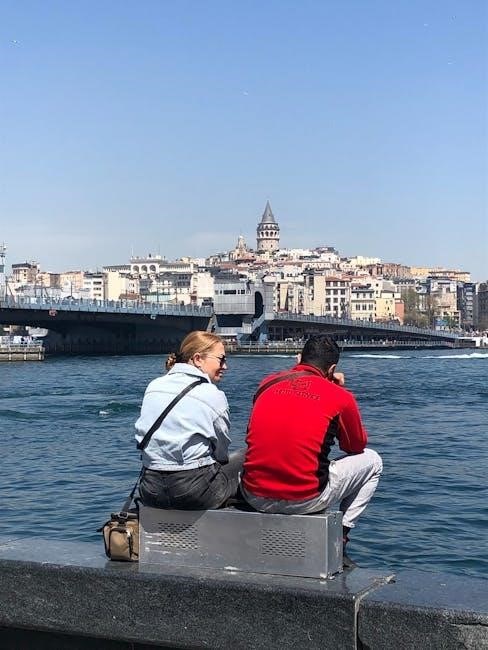Ernest Hemingway’s The Old Man and the Sea, published in 1952, is a timeless tale of perseverance and resilience. This Pulitzer Prize-winning novella follows Santiago, an aging fisherman, as he battles a giant marlin, symbolizing humanity’s struggle against nature. The story, available in PDF format, explores themes of hope, sacrifice, and the indomitable human spirit, cementing its place in literary history.
Overview of the Novel
The Old Man and the Sea, written by Ernest Hemingway, is a novella published in 1952. It tells the story of Santiago, an aging Cuban fisherman, who embarks on a journey to catch a giant marlin after 84 days of failure. The novel explores themes of perseverance, hope, and humanity’s struggle against nature. Hemingway’s concise prose and vivid imagery bring depth to Santiago’s quest, making it a powerful exploration of the human spirit. The novella is widely regarded as a masterpiece of 20th-century literature.
The story is available in PDF format, allowing readers to access this timeless tale easily. Its universal themes resonate across cultures, ensuring its enduring popularity and critical acclaim.
Significance of the Title
The title The Old Man and the Sea reflects the novella’s central themes of human struggle and resilience. The “old man” represents Santiago, embodying humanity’s frailty and determination, while the “sea” symbolizes nature’s vast, untamed power. The title highlights the profound connection between Santiago and the natural world, emphasizing his journey as a universal metaphor for life’s challenges. It also underscores the timeless conflict between humanity and the environment, making the title a poignant summary of the novella’s essence and enduring appeal.
Ernest Hemingway’s Writing Style
Ernest Hemingway’s writing in The Old Man and the Sea is characterized by simplicity, clarity, and a focus on concrete imagery. His distinctive minimalist style avoids elaborate descriptions, instead using sparse, direct language to convey deep emotional and philosophical themes. Hemingway’s “iceberg theory” is evident, where much of the story’s meaning lies beneath the surface. This approach creates a sense of immediacy and intimacy, drawing readers into Santiago’s journey. The novella’s concise prose underscores its universality, making it a landmark of 20th-century literature.

The Plot Summary
The Old Man and the Sea tells the story of Santiago, an aging Cuban fisherman, who after 84 days without catching fish, hooks a giant marlin, embodying his struggle against nature and fate.
The Protagonist: Santiago
Santiago is the aging Cuban fisherman at the heart of The Old Man and the Sea. His perseverance and resilience define his character as he faces an 84-day fishing drought. Despite his physical decline, Santiago’s determination and experience drive him to pursue a giant marlin. His journey is not just a physical battle but an emotional one, reflecting his deep connection to the sea and a quest for personal redemption. Santiago’s story embodies the human spirit’s struggle against nature and adversity.
The Journey: Catching the Giant Marlin
Santiago’s journey begins after 84 days without catching a fish, marking a turning point in his career. He ventures far into the Gulf Stream, where he hooks a colossal marlin. The marlin symbolizes both a challenge and an achievement, testing Santiago’s physical endurance and mental resolve. Despite exhaustion, Santiago’s determination and experience guide him through the grueling battle. The marlin’s enormous size and strength highlight the magnitude of Santiago’s struggle, making this journey a defining moment in his life and a testament to his unyielding spirit.
The Struggle: Battling Sharks and Nature
Santiago’s journey takes a devastating turn when his prized marlin is attacked by sharks. Despite his valiant efforts, the sharks relentlessly devour the marlin, leaving only its skeleton. This struggle symbolizes the harsh reality of nature’s indifference and the inevitability of loss. Santiago’s battle with the sharks mirrors his broader fight against the natural world, highlighting themes of resilience and acceptance. The marlin, once a symbol of triumph, becomes a reminder of the uncontrollable forces that shape human existence, leaving Santiago with a deep sense of loss yet unwavering resolve.
The Ending: A Symbol of Resilience
The novel concludes with Santiago returning to shore, his giant marlin reduced to a skeleton by scavenging sharks. Though defeated, Santiago’s journey embodies resilience. The marlin’s remains, while a testament to loss, also symbolize Santiago’s unwavering determination. His perseverance in the face of nature’s cruelty reflects Hemingway’s exploration of human endurance. Santiago’s acceptance of his fate, rather than despair, underscores the novel’s message of dignity in struggle. The ending leaves readers contemplating the triumph of spirit over adversity, as Santiago’s resolve remains unbroken despite his physical defeat;

Key Themes in the Novel
The Old Man and the Sea explores perseverance, humanity’s struggle with nature, loneliness, and the quest for meaning. These themes resonate deeply in the novella.
Perseverance and Determination
Santiago’s unwavering resolve to catch the giant marlin exemplifies perseverance and determination. Despite 84 days without a catch, he ventures into the Gulf Stream, driven by an unrelenting spirit. His journey symbolizes humanity’s innate will to overcome adversity, even in the face of overwhelming odds. Hemingway’s portrayal of Santiago’s determination highlights the strength of the human spirit, emphasizing that true victory lies not in the outcome, but in the courage to persist. This theme resonates deeply, inspiring readers to embrace challenges with resilience.
The Human Struggle Against Nature
Santiago’s epic battle with the giant marlin embodies the universal human struggle against nature. The old man’s physical and mental endurance is tested as he confronts the vast, uncontrollable sea and its creatures. The marlin, a majestic symbol of nature’s power, represents an unyielding force that Santiago cannot fully conquer. Despite his eventual loss of the marlin to sharks, Santiago’s journey underscores the dignity and courage found in striving against nature’s indomitable will, highlighting the futility yet nobility of human effort.
Loneliness and Isolation
Santiago’s journey in The Old Man and the Sea is deeply marked by loneliness and isolation. As an aging fisherman, he faces prolonged solitude at sea, emphasizing his detachment from society. His 84-day streak without catching fish isolates him further, earning the villagers’ pity. The vast, indifferent sea mirrors his isolation, while his bond with the marlin and nature offers fleeting companionship. Santiago’s solitude underscores his resilience, transforming his struggle into a profound meditation on human existence and the search for connection in a vast, often hostile world.
The Search for Meaning and Purpose
Santiago’s quest in The Old Man and the Sea is a metaphor for the universal human search for meaning and purpose. His relentless pursuit of the marlin, despite overwhelming odds, transcends mere survival, becoming a spiritual journey. The novella explores themes of identity, purpose, and the significance of striving, even in the face of defeat. Santiago’s determination reflects Hemingway’s belief that meaning is found in the struggle itself, not just the outcome, resonating deeply with readers seeking inspiration in their own challenges.

Ernest Hemingway’s Life and Influence
Ernest Hemingway’s life in Cuba inspired The Old Man and the Sea, reflecting his experiences and earning him the Pulitzer and Nobel Prize, solidifying his literary legacy.
Hemingway’s Background and Career
Ernest Hemingway, a renowned American author, was born in 1899 in Illinois. His early life shaped his writing, as he worked as a journalist and ambulance driver in World War I. Hemingway’s distinctive writing style, marked by simplicity and clarity, gained him international acclaim. He settled in Cuba in 1945, where he wrote The Old Man and the Sea, a novella that earned him the Pulitzer Prize in 1953. This work, along with others, solidified his legacy as a literary giant, influencing generations of writers with his unique perspective and storytelling ability.
How His Life Shaped “The Old Man and the Sea”
Ernest Hemingway’s life deeply influenced The Old Man and the Sea. His experiences as a big-game hunter and deep-sea fisherman inspired the novella’s themes of struggle and resilience; Hemingway’s time in Cuba, where he lived near the Gulf Stream, provided the setting for Santiago’s journey. His own struggles with personal challenges and the decline of his career mirrored Santiago’s perseverance. The novella reflects Hemingway’s belief in facing adversity with grace, infusing it with authenticity and emotional depth, making it a testament to the human spirit.
Hemingway’s Nobel Prize and Legacy
Ernest Hemingway was awarded the Nobel Prize in Literature in 1954, recognizing his mastery of narrative and influence on modern writing. The Old Man and the Sea, published two years earlier, was cited as a key work in his recognition. The novella solidified Hemingway’s legacy, showcasing his unique style and thematic depth. His ability to convey profound truths through simple prose left an indelible mark on literature, ensuring his works remain timeless classics, celebrated for their emotional resonance and universal appeal.
The Protagonist: Santiago
Santiago, the aging Cuban fisherman, embodies resilience and determination. His 84-day fishing drought and epic battle with a giant marlin highlight his unwavering spirit and profound connection to the sea.
Santiago’s Character and Traits
Santiago is portrayed as a determined and resilient old fisherman, deeply connected to the sea. His 84-day fishing drought reflects his perseverance. Despite his physical frailty, his indomitable spirit and wisdom shine through. Santiago’s unwavering dedication to his craft and his respect for nature highlight his strong moral fiber. His journey is a testament to his courage and the human spirit’s ability to endure adversity, making him a timeless and relatable protagonist.
His Relationship with the Sea
Santiago’s bond with the sea is one of profound respect and harmony. The sea is his livelihood, a source of sustenance, and a reflection of his identity. He views it with reverence, understanding its power and beauty. In the PDF version of the novel, Santiago’s dialogue often personifies the sea, showing a deep emotional connection. His journey symbolizes humanity’s relationship with nature—both nurturing and unforgiving. The sea represents his life’s purpose, and his respect for it underscores his resilience and admiration for its majesty.
Santiago’s Journey as a Symbol of Human Spirit
Santiago’s journey embodies the essence of the human spirit, reflecting resilience, hope, and determination. His relentless pursuit of the marlin, despite overwhelming odds, symbolizes humanity’s eternal struggle against nature and adversity. The PDF version of the novel highlights his unwavering resolve, even in defeat, showcasing the triumph of the spirit over physical limitations. Santiago’s voyage is a universal metaphor for the human condition, reminding readers that true victory lies not in outcomes but in the courage to endure and persevere.

The Symbolism of the Marlin
The marlin symbolizes nature’s grandeur and humanity’s striving for achievement. It represents the uncontrollable forces of nature, while Santiago’s pursuit embodies human determination and existential struggle.
The Marlin as a Symbol of Achievement
The marlin in The Old Man and the Sea is a powerful symbol of achievement, representing the pinnacle of Santiago’s fishing career. Its enormous size and strength signify the magnitude of human aspirations. Despite the ultimate loss of the marlin to sharks, its presence underscores Santiago’s triumph in catching it, proving his worth as a fisherman. The marlin embodies the idea that true accomplishment lies not in material gain but in the act of striving and perseverance against overwhelming odds.
The Marlin’s Role in Santiago’s Journey
The marlin serves as the central catalyst for Santiago’s journey, embodying both challenge and fulfillment. Its enormous size and strength test Santiago’s skills and determination, pushing him to his limits. The marlin’s presence drives the narrative, symbolizing the elusive nature of greatness and the human quest for mastery. Despite the eventual loss of the marlin to sharks, its role in Santiago’s life underscores themes of perseverance and the transformative power of struggle, making it an integral symbol of his personal and existential quest.
The Marlin as a Representation of Nature
The marlin symbolizes the untamed power and beauty of nature, embodying both its majesty and indifference. Its colossal size and strength represent the overwhelming forces Santiago confronts, reflecting humanity’s fragile relationship with the natural world. The marlin’s struggle alongside Santiago highlights the interconnectedness of life, where predator and prey coexist in a delicate balance. This relationship underscores Hemingway’s exploration of nature as a force that inspires awe yet remains beyond human control, shaping Santiago’s journey and the novel’s themes of resilience and humility.

Themes of Man vs. Nature
The novel masterfully explores the classic conflict between humanity and nature, highlighting their intertwined struggle and coexistence. Santiago’s journey embodies the human spirit’s resilience against nature’s vast, unyielding power.
The Struggle Between Humanity and the Environment
The novel vividly portrays the eternal conflict between humanity and nature, emphasizing resilience and the futility of human efforts against the environment’s vast power. Santiago’s journey symbolizes this struggle, as he battles the giant marlin and relentless sharks, representing nature’s indomitable force. Despite his determination, the sea’s fury highlights the delicate balance between human spirit and natural elements, showcasing both the beauty and brutality of the environment. This theme underscores the nobility of human effort, even in the face of inevitable defeat, reflecting Hemingway’s deep appreciation for nature’s complexity.
Nature as Both Friend and Foe
Nature’s dual role is central to the narrative, serving as both a source of sustenance and a force of destruction. The sea provides Santiago with his livelihood, yet its unpredictability and ferocity challenge his survival. The giant marlin symbolizes nature’s beauty and power, while the sharks embody its ruthless destructiveness. This duality underscores the delicate balance between humanity and the environment, highlighting both the necessity of nature and its capacity to inspire awe and fear. Hemingway’s depiction of nature as both nurturing and adversarial reflects the complexities of human existence within the natural world.
The Unavoidable Battle with the Natural World
The struggle between Santiago and the natural world is inevitable and profound. The old man’s journey represents humanity’s inherent conflict with nature, where survival hinges on understanding and respecting its power. Hemingway portrays this battle through Santiago’s relentless pursuit of the marlin and his subsequent loss to the sharks. This clash underscores the idea that while nature can inspire awe, it is also indifferent to human endeavors, making the struggle both a test of will and a reminder of human limitations in the face of the wild.

Religious and Spiritual Undertones
Santiago’s journey embodies spiritual themes, reflecting faith, sacrifice, and redemption. His perseverance mirrors a pilgrimage, where his unwavering resolve and connection to nature symbolize a deeper divine purpose.
Themes of Faith and Hope
In The Old Man and the Sea, Santiago’s unwavering faith in his abilities and the universe’s order reflects a deep spiritual hope. Despite his aging body and 84 days without catching fish, he believes in his destiny and the sea’s bounty. His dialogue with the marlin, expressing respect and determination, underscores his belief in a higher purpose. This faith sustains him through despair, symbolizing humanity’s capacity to endure and find meaning in adversity. Hemingway’s portrayal of Santiago’s resilience highlights hope as a universal, transformative force.
The Symbolism of Santiago’s Journey as a Pilgrimage
Santiago’s journey in The Old Man and the Sea symbolizes a spiritual pilgrimage, reflecting humanity’s search for meaning and transcendence. His solitary voyage into the vast ocean mirrors the introspective nature of a pilgrimage, where one seeks to connect with a higher purpose. The marlin represents a divine challenge, testing Santiago’s resolve and faith. Despite the physical toll, his journey embodies a profound spiritual quest, emphasizing the idea that true fulfillment lies in the pursuit itself, not just the outcome. This symbolism elevates the novella into a universal exploration of the human spirit.
The Idea of Sacrifice and Redemption
Santiago’s journey embodies the themes of sacrifice and redemption, as his perseverance despite overwhelming adversity underscores the novella’s deeper spiritual dimensions. His sacrifice of physical comfort and safety symbolizes the human willingness to endure hardship for a greater purpose. The loss of the marlin, while devastating, serves as a form of redemption, proving Santiago’s unwavering spirit and earning the respect of his community. This duality of sacrifice and redemption highlights the novel’s exploration of personal triumph and the enduring human spirit, resonating universally with readers.

The Novel’s Reception and Awards
The Old Man and the Sea earned Ernest Hemingway the Pulitzer Prize in 1953 and contributed to his Nobel Prize in Literature in 1954.
The Pulitzer Prize Recognition
Ernest Hemingway’s The Old Man and the Sea received the Pulitzer Prize in 1953, marking a pinnacle in its literary acclaim. This prestigious award acknowledged the novella’s profound exploration of resilience and the human spirit; The prize solidified Hemingway’s reputation as a master of modern literature and highlighted the universal themes that resonate throughout the story. The recognition also underscored the novel’s enduring appeal, making it a timeless classic available in PDF for readers worldwide to appreciate its beauty and depth.
Critical Acclaim and Reviews
The Old Man and the Sea garnered widespread critical acclaim upon its release, with reviewers praising its simplicity and depth. The novella’s sparse prose, a hallmark of Hemingway’s style, was celebrated for its ability to convey profound emotions and universal themes. Critics noted the symbolic richness of Santiago’s journey, interpreting it as a reflection of human perseverance. Available in PDF, the novel continues to be admired for its literary brilliance, with many considering it a masterpiece of 20th-century literature. Its enduring popularity is a testament to its timeless appeal.
Impact on Hemingway’s Career
The Old Man and the Sea marked a career resurgence for Ernest Hemingway, earning him the Pulitzer Prize in 1953. This acclaim revitalized his reputation and set the stage for his Nobel Prize in Literature in 1954. The novella’s success demonstrated Hemingway’s ability to craft profound, concise narratives, solidifying his legacy as a literary giant. Available in PDF, the book remains a cornerstone of his oeuvre, showcasing his mastery of themes that resonate universally. Its impact continues to influence writers and readers alike, ensuring Hemingway’s enduring relevance.

The PDF Version of the Novel
The Old Man and the Sea is widely available in PDF format, offering readers a convenient way to access Hemingway’s timeless tale of resilience and determination.
Availability of “The Old Man and the Sea” in PDF Format
Availability of “The Old Man and the Sea” in PDF Format
The novel is widely available in PDF format, making it easily accessible to readers worldwide. Fans of Ernest Hemingway can download the PDF version from various online platforms, including literary websites and digital libraries. The PDF format ensures that the text remains clear and readable on multiple devices, preserving the original prose and structure. Additionally, the PDF version is often accompanied by other formats like EPUB and Mobipocket, catering to different reading preferences. This accessibility has helped the novella maintain its popularity, allowing new generations to discover Hemingway’s masterpiece. The convenience of the PDF version has made it a favorite choice for both casual readers and academic purposes. However, users are advised to ensure they download from authorized sources to avoid copyright issues. The PDF version is a testament to the enduring appeal of The Old Man and the Sea, ensuring its timeless story reaches a global audience.
Benefits of Reading the Novel in PDF
Reading The Old Man and the Sea in PDF format offers numerous advantages. The text remains crisp and well-formatted, ensuring an immersive reading experience. PDFs are easily accessible on various devices, including smartphones, tablets, and e-readers, allowing readers to enjoy the novel anywhere. Additionally, the digital format eliminates the need for physical storage, making it environmentally friendly. The ability to zoom in and adjust font sizes enhances readability, while features like bookmarks and search functions improve navigation. This convenience makes the PDF version a popular choice for modern readers.
Where to Download the PDF Legally
To legally download The Old Man and the Sea in PDF format, consider reputable sources like Amazon Kindle, Google Books, or Barnes & Noble. Many eBook platforms offer the novella for purchase or rental. Additionally, check libraries like OverDrive or Scribd, which provide access to digital books with a subscription. Ensure you use authorized distributors to support the author and publisher. Always verify the legality of the source to avoid copyright infringement and promote ethical reading practices.

Cultural and Literary Significance
The Old Man and the Sea holds a cherished place in American literature, reflecting themes of resilience and the human struggle against nature. Its universal appeal continues to inspire readers globally, solidifying Hemingway’s legacy as a literary giant. The novella’s profound exploration of the human spirit has made it a cultural icon, influencing numerous adaptations and works across various mediums. Its enduring popularity underscores its timeless relevance in modern society.
The Novel’s Place in American Literature
The Old Man and the Sea is a cornerstone of American literature, renowned for its concise yet profound storytelling. Hemingway’s final major work, it solidified his legacy as a literary icon, earning him the Pulitzer Prize. The novella’s universal themes of resilience and human struggle resonate deeply, making it a timeless classic. Its influence on modern literature is immense, inspiring countless adaptations and works. As a cultural touchstone, it remains widely studied and admired, ensuring its enduring relevance in American literary history.
Influence on Other Works and Authors
The Old Man and the Sea has profoundly influenced literature and authors worldwide. Hemingway’s minimalist style and exploration of human resilience inspired writers like Gabriel García Márquez, who admired the novella’s emotional depth. Its themes of struggle and perseverance have been adapted in films, literature, and even music, cementing its cultural impact. The novella’s concise yet powerful narrative has become a benchmark for storytelling, encouraging authors to explore simplicity and symbolism. Hemingway’s legacy continues to inspire new generations of writers and artists, ensuring his work remains timeless and influential.
Cultural Impact and Popularity
The Old Man and the Sea has left an indelible mark on global culture, resonating with readers from diverse backgrounds. Its themes of resilience and hope have made it a beloved classic, widely studied in schools and universities. The novella’s popularity extends beyond literature, influencing art, film, and even music. Its availability in PDF format has further expanded its reach, allowing readers worldwide to access Hemingway’s masterpiece. This enduring popularity underscores the universal appeal of Santiago’s journey, making it a cultural icon of the 20th century.
The Old Man and the Sea remains a timeless masterpiece, symbolizing resilience and hope. Its availability in PDF ensures Hemingway’s legacy endures, inspiring future generations universally.
Final Thoughts on the Novel
The Old Man and the Sea is a profound exploration of resilience, hope, and the human spirit. Hemingway’s sparse yet powerful prose captures Santiago’s journey, transforming it into a universal tale of perseverance. The novella’s themes of struggle and redemption resonate deeply, making it a timeless classic. Its availability in PDF format ensures accessibility for modern readers, allowing Hemingway’s masterpiece to continue inspiring future generations with its enduring message of courage and determination in the face of adversity.
The Timeless Appeal of “The Old Man and the Sea”
The Old Man and the Sea endures as a literary masterpiece, captivating readers with its universal themes of resilience, hope, and the human struggle against nature. Hemingway’s concise, powerful prose and the novella’s emotional depth continue to resonate across generations. Its availability in PDF format ensures accessibility, allowing readers to connect with Santiago’s journey and reflect on life’s challenges and triumphs. The story’s timeless appeal lies in its ability to inspire and evoke contemplation, solidifying its place as a beloved classic in world literature.
Hemingway’s Legacy Through This Work
The Old Man and the Sea is a cornerstone of Ernest Hemingway’s literary legacy, earning him a Nobel Prize and solidifying his influence on 20th-century literature. The novella’s themes of perseverance and the human spirit resonate deeply, reflecting Hemingway’s personal experiences and philosophical outlook. Its availability in PDF format ensures continued accessibility, introducing new generations to Hemingway’s unique style and profound insights; This work remains a testament to his enduring impact on storytelling and literary artistry.


